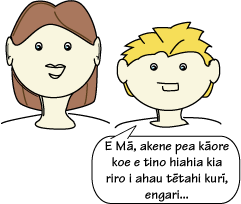|
||||||||||
|
|||||||
Questions/instructions:
|
|||||||
| %
responses |
|||||||
| • Käore e tino nui te wähi e tü ana tö whare. | whakahë
|
35 |
|||||
| • He nui ngä motukä i te huarahi kei te wähi e noho ana koe. | whakahë
|
25 |
|||||
| • He pai te kurï hei whakamataku i ngä nanakia, ngä whänako, tërä pea ka tüpono atu ki tö whare. | tautoko
|
35 |
|||||
| • Ko te mahi pai ki tö whaea, ko te tiaki i tana mära putiputi. | whakahë
|
26 |
|||||
| • He puare kei te taiapa e karapoti ana i tö whare. | whakahë
|
20 |
|||||
| • He tino pai te kurï hei hoa mö te tangata. |
tautoko |
41 |
|||||
| • Käore e nui te moni a töu whaea. | whakahë
|
9 |
|||||
| • He mahi täu i muri i te kura – he kawekawe nüpepa ki ngä käinga i tö rohe. |
tautoko |
22 |
|||||
| • He nui ö mahi häkinakina i muri i te kura. | whakahë
|
20 |
|||||
| • He ngäwari noa iho te whakaako kurï. | tautoko
|
35 |
|||||
1. Tuhia ki konei te tau (nama) o ngä take e tautoko ana i te whakaaro kia riro i a koe tëtahi o ngä punua kurï, me ngä take e whakahë ana. [answers as given above] |
|||||||
| 2. He aha ö körero ki tö whaea kia whakaae mai ia kia riro i a koe he punua kurï? | |||||||
included
“körero whakapati” |
52 |
||||||
| Pros used in argument : | 2
or more pros given |
13 |
|||||
1
pro given |
11 |
||||||
no
pros given |
76 |
||||||
Commentary: |
|||||||
